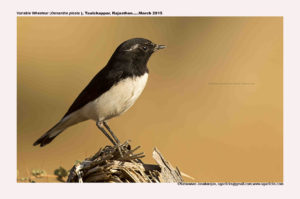Variable Wheatear-Picata

Variable Wheatear Oenanthe Picata
Etymology:
- Oenanthe : Greek word oinanthe – unidentified bird mentioned by Aristotle
- Picata : : Latin word for “ Black and white, like smeared in Tar”
Vernacular Names: Baluchistan: Monu, Pun: Dabbigalri, Guj: Kabaropiddo, Strickland-no piddo, Mar: KabraRangoja
Distribution in India:Winter visitorin North West India.
Description: Size of 15 cm; wt. of 20–25 g. The male of “picata” morph is small, smaller-headed and less glossy, with lower back and upper breast black, paler flight-feathers below. The female is like male, but black replaced by darkish brown, underparts are dull whitish. The Juvenile resembles female, but with broader buff wing edges above, vague buffy scaling below.
Habitat: It is found in highly weathered low mountains, among sand deserts with grass vegetation, stony outcrops and clay canyons. “Picata” occurs in foothills to 2100–2400 m.
Food habits: It eats small insects, ants, small beetles, flies and small grasshoppers, also larger insects likemoths and also fruit of Ficus and berries of Grewia. The prey is pursued very actively on ground, in air and from low rock perch.
Breeding habits: They breed in Mar–Jun in C Asia; Jun–Jul in Afghanistan and Mar to Jul in Pakistan. At start of nest-building female brings numerous flat stones to nest-site. The nest is a bulky, flat cup of grass stems, feathers, animal hair and wool, well concealed in hole in rocks, cliff, wall or bank, under flat stone on rocky slope or in burrow. They lay a clutch of 4-7. The incubation period is 12–13 days. The nestling period is 13–14 days.